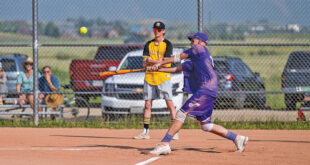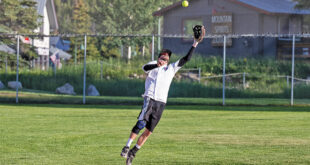by Toni Todd
From arm-balls to zooters, scientist-athletes put unique spin on a classic game
It starts with a bare-handed circle-catch on a dirt patch at dusk, there in the shadow of Gothic Mountain. It’s a mellow warm-up of friendly, high-arching tosses, players careful not to step on billy barr’s meticulously-laid chalk lines.
Three yellow wickets, or posts, mark each end of a narrow, 22-yard rectangular strip known as the pitch.
It’s the first practice match of the Gothic Cricket Club at the Rocky Mountain Biological Laboratory this summer.
A crowd of spectators grows. Fans perch on a mound of grass and boulders at the batsman’s end of the pitch. They stand on pathways skirting the dirt, phones held aloft, ready to tap buttons and freeze-frame the action.
Cricket is typically played with batsmen hitting from both ends of the pitch, but in Gothic, limited space allows batting only one direction. Hitting the other way would likely shatter some glass. It’s a miracle windows aren’t smashed anyway.
For the practice match, sides are chosen like playground kickball. Teams huddle to discuss their first-inning strategies. Some players are veterans of the Gothic Cricket Club. Others have never seen cricket played before, much less played the game themselves. But all are welcome. The teams break apart. The wicket-keeper, or catcher, the only player with mitts—yes, two—stands ready behind the wickets. The bowler, or pitcher, does the same at the opposite end. The bowler takes a few practice throws. Fielders position themselves strategically around the outfield.
The first batsman steps to the plate. The bowler throws. Game on.
There are 11 members per team in cricket—usually. Rachel Dickson, a veteran cricketer from Missoula, Mont. who studies pollinator networks, says the number of players per team in the Gothic Club is “as many as come.”
Mary Rice, from Tucson, is the umpire. It’s her 40th summer in Gothic, where she studies pollinator preferences and the impact those preferences have on plants. She says the most important qualification for her position is not knowledge of the game, but impartiality. “I’m the perfect ump,” she says, “because I’m not partisan.”
“It’s fun and different,” says Lydia Fisher from Lancaster, Pa. Fisher studies butterflies. “It’s a good way to interact with people you normally wouldn’t.”
Rachel Steward is an evolutionary ecologist who also studies butterflies. “I love all sports,” she says, flipping numbers on the scoreboard in-between shouts of coaching advice to her teammate. “Hanna—scoot a little bit closer.” Steward has played four summers and is now a team captain. “By the time I came here, it was already a full-fledged phenomenon,” she says.
Official match play started last week. There are four captains of teams with names like the Musty Marmots and the Sneaky Weasels.
“I think it was 2012 or 2013,” says Paul CaraDonna, trying to recall when the club was formed. CaraDonna is an assistant professor at the Chicago Botanical Gardens at Northwestern University. He’s been coming to RMBL since 2011. “I had never played cricket before, but have been a big fan since.”
CaraDonna is a captain and go-to guy for newer players. He’s got a distinctive move as a bowler, chest puffed out with a slow, double arm-circle just before his run-up to the pitch. CaraDonna’s bowling seems polished—good form, as they say.
“billy barr loves cricket, and we all play because he got us into it. It’s super fun,” says CaraDonna. “billy became interested in the sport because he loves Bollywood movies and they are always playing cricket in India. One thing lead to the next and now we have the Gothic Cricket Club.”
CaraDonna can’t say what aspect of the game he loves the most. “I describe it as ‘dynamic baseball,’” he says. “The ball can be hit anywhere, bowling is a lot of fun, running is a blast, and fielding is great, too. It’s a great way to switch gears after a long day in the field.
“Most of the newcomers say, ‘I know nothing about cricket.’ My response is usually, ‘Don’t worry, almost everyone else who plays at RMBL is confused too.’ In actuality, it’s a pretty simple game. I think that’s what keeps people coming back, even if there are some complicated rules. And it’s a great way to interact with others in our community. Many of us work on different projects and field teams during the day, and so cricket brings all of us together in a totally different way.”
The matches are always competitive, but it doesn’t hurt to have the most veteran captain of them all as your leader. Even to the most unseasoned cricket-observer, billy barr, the club’s founder, is the player to watch and emulate. “Of course, billy’s team always wins,” says Steward.
The Gothic Cricket Club brings scientists together from around the world in a way like nothing and no place else. There are no ringers, per se, for nobody who plays in Gothic grew up with cricket. Even so, many of the players demonstrate impressive athletic skill. They’ve learned it, fallen in love with it, and put their own, unique stamp on a centuries-old game. Veterans coach and encourage, while newcomers stumble to their positions, dazed yet excited to play. Regular fans orient new spectators to the nuances of cricket. It all happens in a magical place, on a dusty pitch engulfed by the soft hue of alpenglow and the scent of deep woods, where marmots sound alarms, wildflowers sway in the high-alpine breeze, and mosquitos gorge on reporters.
A batsman cracks the ball. The crowd hoots and cheers and shouts, “Run! Run!” Fielders dart between buildings, scoop up balls from the dirt, snag balls from the air, dive into the crowd, grab balls up from out of the dandelions under the solar panels, fly between cars to snatch pop-ups before they drop from the sky and dent someone’s hood, hustle up and over the berm to make the throw. All balls are playable. Runners sprint. Wicket-keepers catch and tag the wickets. Safe, or out. Scores flip. Applause. Woo-hoos. A guy dressed like Inspector Gadget with an impossibly black Charlie Chaplin mustache and a homemade press pass tucked into his hat snaps photos from every angle, muttering names under his breath, because he somehow knows all the players. The Inspector says he’s from Sports Illustrated. I tell him I’m from ESPN.
Who says scientists don’t have game?
 The Crested Butte News Serving the Gunnison Valley since 1999
The Crested Butte News Serving the Gunnison Valley since 1999



